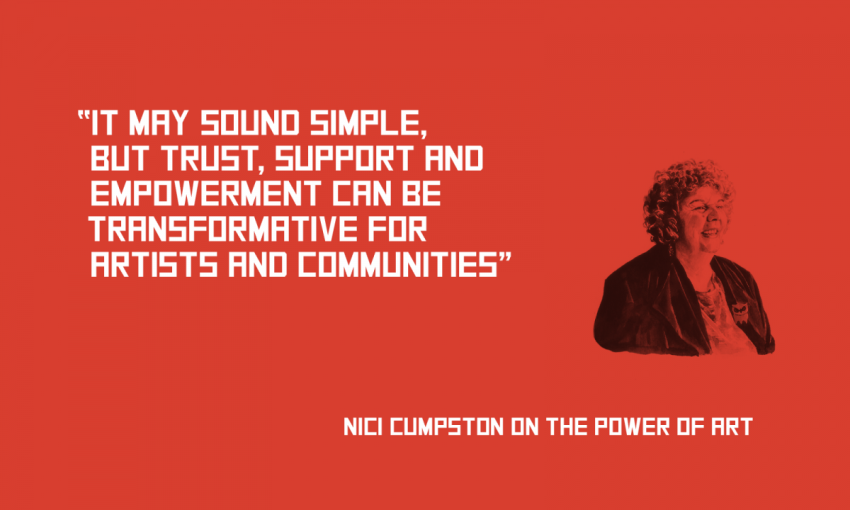More than a soft power, art, properly supported, can act as a vehicle of empowerment and cultural visibility.
Nici Cumpston on the power of art
Aboriginal spears from South Australia are hitting their mark around the world.
Adelaideans saw them in the grounds of Government House during the 2015 TARNANTHI Festival of Contemporary Aboriginal & Torres Strait Islander Art, in a powerful night-time art installation about land rights as part of the Kulata Tjuta (‘many spears’) project by artists from the Anangu Pitjantjatjara Yankunytjatjara Lands (APY).
Kulata Tjuta became airborne at TARNANTHI last year in a giant suspended work referencing an atomic mushroom cloud, highlighting loss and dispossession. Now Kulata Tjuta will soar internationally when it features as a major element in The Fondation Opale, founded by Bérengère Primat, an art museum dedicated to contemporary Indigenous Australian art, in Lens, Switzerland.
For this ongoing project, older men in numerous APY communities teach younger men spear-making skills while sharing traditional stories. It shows how art can be a way to tell important stories, to express and reinforce connections to land and culture, and to increase community pride. Art is a powerful medium for Aboriginal communities.
Art can also be a medium for empowerment, as evidenced by TARNANTHI, an Art Gallery of South Australia flagship project showcasing the diversity and depth of contemporary Aboriginal and Torres Strait Islander art nationwide.
TARNANTHI encourages Aboriginal artists and their communities to ask ‘what if’ – to dare to dream big. And for Aboriginal people, our country’s most marginalised citizens, that can be a potent concept.
Artists develop new work specifically for the festival. As Artistic Director, I speak with artists about their current practice and see if they want to expand it in more ambitious ways, then find out how TARNANTHI can help to turn these bigger dreams into a reality of excellence. Support extends from providing artist fees and material costs, to more complex matters, such as facilitating the technical support that helped to present Kulata Tjuta as a major work to a national audience at TARNANTHI. This approach is vastly different to simply displaying existing work. Crucially, it involves establishing mutual trust and building relationships over a long period of time – it’s a personal investment for all involved.
It may sound simple, but this approach of trust, support and empowerment can be transformative for artists and communities. I’ve now seen countless TARNANTHI artists soar in assurance and proficiency, their works now telling stories more boldly to wider audiences.
For audiences, TARNANTHI allows a first-hand experience of the vigour and variety of Aboriginal art. It provides a rare platform for Aboriginal views and voices to be seen and heard. It shows Aboriginal culture to be ingenious, multi-faceted, adaptive, evolutionary, even revolutionary. I believe that this expands our understanding of who we are as a nation, empowering us to grow as a nation.
Behind TARNANTHI’s soft power lies some solid support. The Art Gallery, as a state institution, lends an authoritative weight. There is also the critical backing of principal partner BHP, whose five-year financial commitment makes possible all that TARNANTHI does. This partnership, itself a relationship built on trust, empowers TARNANTHI to champion Aboriginal and Torres Strait Islander art.
Art is often said to have a transformative, uplifting power. With TARNANTHI, the power of art embraces the art of empowerment.




